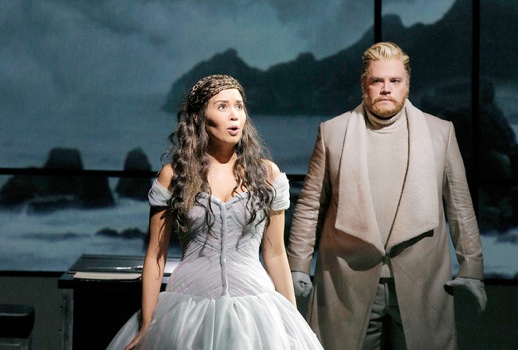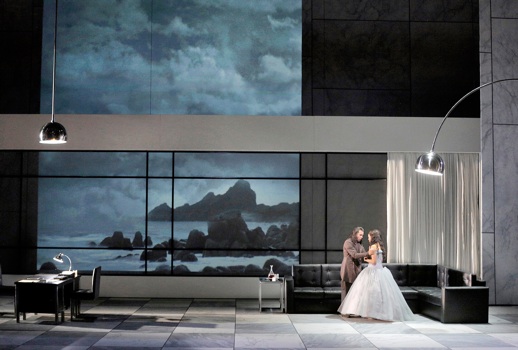

Finally, Erna Berger makes her way to the door and the woman says “why, it was such lovely music!”
Berger dryly responds, “No, lady. It was not.”
Well that’s a terrible place to start a review, and it’s not quite fair to SFO’s Lucia di Lammermoor, but it did come to mind when the gentleman behind me reacted in delight to the sextet. “I think that’s the finest moment of opera I’ve ever heard,” said he, and immediately my inner Erna Berger, of which I assume we all have one, chimed in with her tart opinion. That this relates to the sextet is apt, as the story of the whole night is: largely fabulous parts adding up to a somewhat lackluster whole.
Let’s take Piotr Beczala, for instance. In certain roles, and I’m thinking foremost of Des Grieux, Beczala is pretty much nonpareil. As Edgardo, though, I can’t help but think of him as basically top notch but just a little bit pareil, if only around the edges. He made lovely sounds, and his phrasing was never careless, and even his acting was not inferior to anyone’s in particular. Just the same, it wasn’t a performance to set the soul ablaze. (His Des Grieux was.)
I’m just going to call all the men’s roles Edgardo, by the way, because that’s how they’re filed in my head, and I can’t seem to do much about it. Brian Mulligan, as the Edgardo who is a baritone, proved again his great worth to the company, turning in perhaps the evening’s most complete performance.

I went into the evening a little nervous for Nadine Sierra. Musetta is one thing, and Lucia another. As it happens, her Lucia is exquisite. The tone is sweet but not without requisite shadow, where needed, and she uses dynamic changes, as fine bel cantists do, a bit like sentence intonation rather than just sprinkling them about for variety.
Dramatically, a Lucia can get by well enough if she can walk backward in a long dress—and in fact, Ms. Sierra was kitted out in enough dress for several genteel madwomen—but she rose above the pretty girl poses that occasionally marred her Figaro Countess and made something pitiable of the role.

Smaller roles were ably handled, though one almost downgraded Nicolas Teste’s earthy, attractive bass when he entered done up for the Westeros PTA. Zanda Svede did about as much as you can with She-Edgardo, and looked elegant. After a croaky go at the opera’s opening music, which in fairness tends naturally toward the ranid, Maestro Nicola Luisotti gave a poised account of much of the music, lapsing now and again into boxy tempos.
Duty-bound to present you with my unalloyed pronouncements, I have not yet read what other critics have said about Michael Cavanagh’s new production, but I’m awfully curious. For my money, the devil-may-care century-mixing of the scenic and costume design leaves one little option but to pretend it is 1997, when people still used the word “postmodern.”

I doubted there would be pictures of this in the press release, but some will be interested to know that supernumerary Charlie Martinez, as press materials tell us, “makes his San Francisco Opera stage debut as the stand-in for the murdered Arturo, found naked and bloody in the wedding bed.”
Photos ©Cory Weaver/San Francisco Opera


























Comments